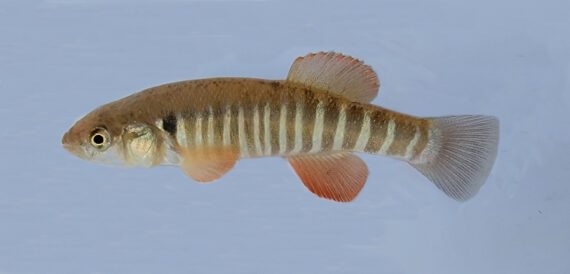Plains Killifish, Fundulus zebrinus
 Plains Killifish, Fundulus zebrinus. Fish caught from Red River, Denison, Texas, June 2023. Catch, photograph, and identification courtesy of Chris Moore, Peoria, Arizona.
Plains Killifish, Fundulus zebrinus. Fish caught from Red River, Denison, Texas, June 2023. Catch, photograph, and identification courtesy of Chris Moore, Peoria, Arizona.
The Plains Killifish, Fundulus zebrinus, is a member of the Topminnow and Killifish or Fundulidae Family, that is also known as Topminnow and in Mexico as sardinilla cebra. Globally, there are thirty-nine species in the genus Fundulus, of which five are found in Mexican waters, four in the Atlantic and one in the Pacific Ocean.
The Plains Killifish has a slender elongated round body with a straight profile. They vary in color from brown, to black, to greenish, to straw color. They have 12 to 28 dark vertical bars on their sides, from which they derive their species name. They are sexually dimorphic with the males having wider and darker bars than the females and breeding males have bright orange fins. They are sexually dimorphic with the males having wider and darker bars than the females; breeding males have bright red fins. Their dorsal fin has 13 to 16 rays and is inserted before the anal fin. Their head is broad and flat with s uptilted mouth that has a massive protruding jaw with numerous teeth. Their anal fin is elongated and sharply angulate; their caudal fin is truncate; their dorsal fin is long and rounded; their pectoral and pelvic fins are ovate with the pectoral fins being much longer than the pelvic fins. They are covered with large scales.
The Plains Killifish is found in very shallow sandy runs, pools and backwaters of headwaters, creeks and small to medium rivers with temperatures between 20°C (68°F) and 25°C (77°F). They have a great tolerance for high alkaline, high thermal, low dissolved oxygen, and saline streams. They reach a maximum of 10 cm (3.9 inches) in length. They consume algae, chironomid larvae, copepods, nematodes, insects, and other small invertebrates. They are known to bury themselves into the substrate leaving only the mouth and eyes visible which helps them avoid predation, intense sunlight, locate potential prey and help to survive stream desiccation. They spawn in small shallow pools over sand or gravel and rubble substrate with each female mating with multiple males with the eggs deposited in the substrate; the males defend the territory. They are known to harbor a wide variety of parasites. They have life spans of up to three years. The Plains Killifish is poorly studied with very limited information available about their lifestyle and behavioral patterns, including specific details on age, growth, longevity, movement patterns, diet, habitat use, and reproduction.
The Plains Killifish is not native to Mexico but has been introduced to the lower Rio Conchos and Rio Grande basins in Chihuahua. They have been widely introduced to new areas with most introductions occurring via bait bucket release.
The Plains Killifish is a straightforward identification but can be confused with the Northern Plains Killifish, Fundulus kansae (smaller scales, smaller eyes, less robust body, males with yellow-orange fins and at present not known to be a resident of Mexican waters).
From a conservation perspective the Plains Killifish is currently considered to be of Least Concern with stable, widely distributed populations. Their long-term viability is threatened by human development and the introduction of non-native species including the Green Sunfish, Lepomis cyanellus. They are utilized by the aquarium trade being easy to maintain. They are also used as a bait fish. The total population is believed to exceed 10, 000 individuals. They have been widely introduced; where introduced they become highly invasive displacing native species.